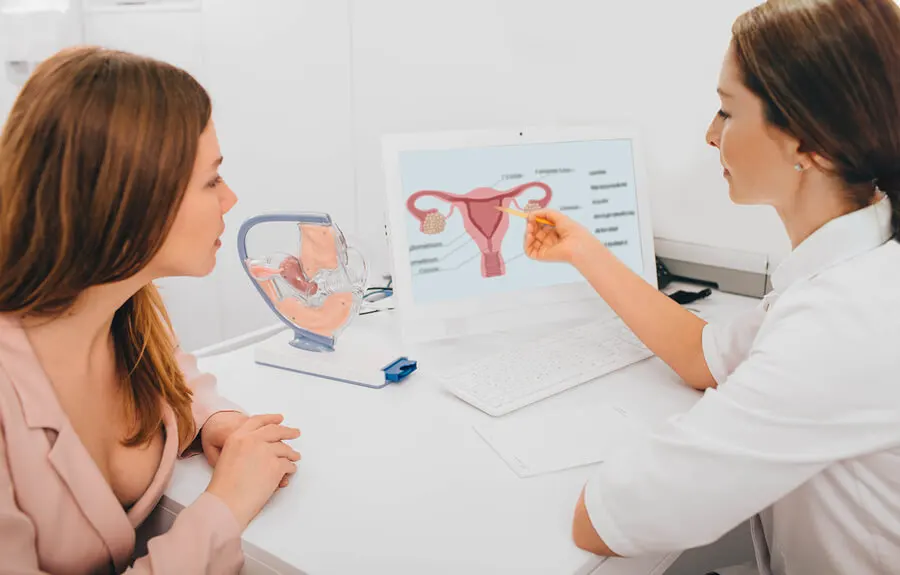Ovulatory Dysfunction: What Is it and How to Deal with It?


Reviewed and approved by the nurse Leidy Mora Molina
Ovulatory dysfunction is an abnormality in a woman’s natural ovulation process. In some cases, ovulation doesn’t occur at all and, in others, it is irregular, intermittent, or abnormal.
When there’s ovulatory dysfunction, it’s very common for the woman to suffer abnormalities in menstruation. Usually, the woman will have either no period at all or a very irregular one. This is due to hormonal alterations.
Ovulatory dysfunction, particularly the absence of ovulation, is one of the main causes of female infertility. However, sometimes this condition is normal, as when it occurs during pregnancy and lactation. Other times, it’s due to problems in the body.
What is ovulatory dysfunction?

Ovulatory dysfunction is a condition in which there is no ovulation or where ovulation occurs irregularly. If there’s an absence of ovulation it is called “anovulation”. If ovulation is irregular, but not completely absent, it is called “oligoovulation”.
During a woman’s normal cycle, a mature egg is released. This can be fertilized by a spermatozoon, thus leading to conception. Obviously, if there is no egg, or if the egg isn’t in good condition, fertilization cannot occur either.
It’s estimated that up to 40% of cases of female infertility are due to ovulatory dysfunction. This condition can be circumstantial or chronic. In some cases, this abnormality can lead to other long-term health problems, such as type 2 diabetes mellitus.
Causes of ovulatory dysfunction
Ovulatory dysfunction has many different triggers, ranging from stress to Polycystic Ovary Syndrome. However, the World Health Organization (WHO) has classified the causes into three main groups, as we will see below.
Hypothalamic-pituitary failure
In this case, ovulatory dysfunction is due to failures in the hormonal secretion of the hypothalamus and pituitary gland. Specifically, the hypothalamus doesn’t produce enough GnRH and the pituitary doesn’t release enough gonadotropins. These hormones regulate the menstrual cycle. It corresponds to 10% of cases.
The reasons for failure of the hypothalamus or pituitary are as follows:
- Kallman’s syndrome
- Hypogonadotropic hypogonadism
- Excessive physical exercise
- Weight gain and loss, especially due to anorexia or bulimia
- Chronic renal insufficiency
- Chronic liver disease
- Other systemic diseases
Hormonal alterations
In this group, we have Polycystic Ovary Syndrome, considered the most common cause of ovulatory dysfunction. This is an endocrine disorder that causes the absence of menstruation in women or very irregular cycles.
Women with this disorder have enlarged ovaries and fail to produce mature eggs. Signs of hyperandrogenism, or masculine traits, are also common in these women.
You may also be interested in: 5 Symptoms of Polycystic Ovary Syndrome
Within this group, there are also other diseases such as hyperprolactinemia, or very high levels of the hormone prolactin, as well as thyroid disorders. Both of these factors cause ovulatory dysfunction.
Ovarian failure
Premature ovarian failure or early ovarian failure is another cause of ovulatory dysfunction. It’s estimated that between 4% and 5% of cases are due to this reason. This condition is characterized by a woman’s ovaries stopping functioning before the age of 40; that is, without having reached the average age of menopause.
Thus, hormone levels are relatively adequate, but the ovaries fail to produce mature eggs. In addition, in some cases, there’s an estrogen deficiency.
Symptoms and diagnosis
The main symptom of ovulatory dysfunction is the absence or intermittency of menstruation. Likewise, in these cases, there are no symptoms of premenstrual syndrome and there’s no abundant and elastic cervical mucus, which is characteristic of fertile days in women.
In some cases, women with ovulatory dysfunction do have menstruation, but it has some peculiarities:
- Cycles lasting less than 21 days or more than 36 days
- Cycle length varies greatly from month to month
- Bleeding is abnormal
Also, some women with this disorder don’t have any symptoms. They only realize that they have this condition when they try to get pregnant and don’t succeed.
The diagnosis is usually made based on one or more of the following actions:
- Monitoring of basal body temperature
- Progesterone blood test
- Ultrasound
Get to know more: Ovary Pain: A Symptom of a Bigger Problem
Treatment of ovulatory dysfunction

The treatment of ovulatory dysfunction depends on what is producing it. Sometimes a change in lifestyle is sufficient, which includes reducing stress, regularizing diet, losing weight, or moderating physical activity.
If there’s a hormonal imbalance, fertility medications are most commonly prescribed. Clomid is usually used. It’s estimated that this drug triggers ovulation in up to 80% of women who don’t have ovulation.
If polycystic ovary syndrome is present, metformin may be prescribed. Sometimes myoinositol, an over-the-counter supplement, is also used. If these substances don’t work, they may be combined with fertility medications. This increases the chance of success.
If the cause of the ovulatory dysfunction is premature ovarian failure, the drugs will most likely not work. In this, and in other cases in which the treatment isn’t successful, the alternative is to try In Vitro Fertilization (IVF).
Detecting an anomaly means knowing one’s own body
It’s important to emphasize that women with this dysfunction don’t necessarily stop menstruating, neither partially nor completely. Therefore, it’s important to be attentive to the length of cycles and bleeding in order to detect a possible abnormality.
Lifestyle plays a very important role in this area. In particular, you need to take good care of your diet and maintain a calm state of mind. Stress can lead to ovulatory dysfunction.
All cited sources were thoroughly reviewed by our team to ensure their quality, reliability, currency, and validity. The bibliography of this article was considered reliable and of academic or scientific accuracy.
- Magendzo, N. A. (2010). Anovulación y disfunción ovulatoria e infertilidad. Revista Médica Clínica Las Condes, 21(3), 377-386.
- Sánez, H. A. M., Arroyo, L. H., & Madrigal, D. M. M. (2012). Hipotiroidismo e infertilidad femenina. Revista Mexicana de Medicina de la Reproducción, 4(1), 3-6.
- Masoli, I. D. (2010). Diagnóstico de la infertilidad: estudio de la pareja infértil. Revista Médica Clínica Las Condes, 21(3), 363-367.
This text is provided for informational purposes only and does not replace consultation with a professional. If in doubt, consult your specialist.








